Manchester City are coming off an incredible 2018/19 season.
Pep Guardiola led his team to a domestic treble, winning the Premier League, the FA Cup, and the League Cup.
It seems difficult to see where this Manchester City team can improve, but with a big signing already made, Guardiola seems to know that the 2019/20 season.
The has been huge pressure from all angles about winning the Champions League, a trophy Manchester City have never won, and a trophy Guardiola hasn’t been able to get his hands on since 2011, eight years ago.
Whether the criticism is fair or not is a different story, but all eyes will be watching Manchester City this season, wondering if the can finally crack Europe without letting domestic form slip.
This tactical analysis and scout report will look at how Guardiola sets up Manchester City, and how new changes to the team may help them take it one step further in Europe.
Lineup and style of play
Guardiola is quite flexible in his formations, but his preferred formation is a 4-3-3.
He will often change the formation depending on the team he is playing against.
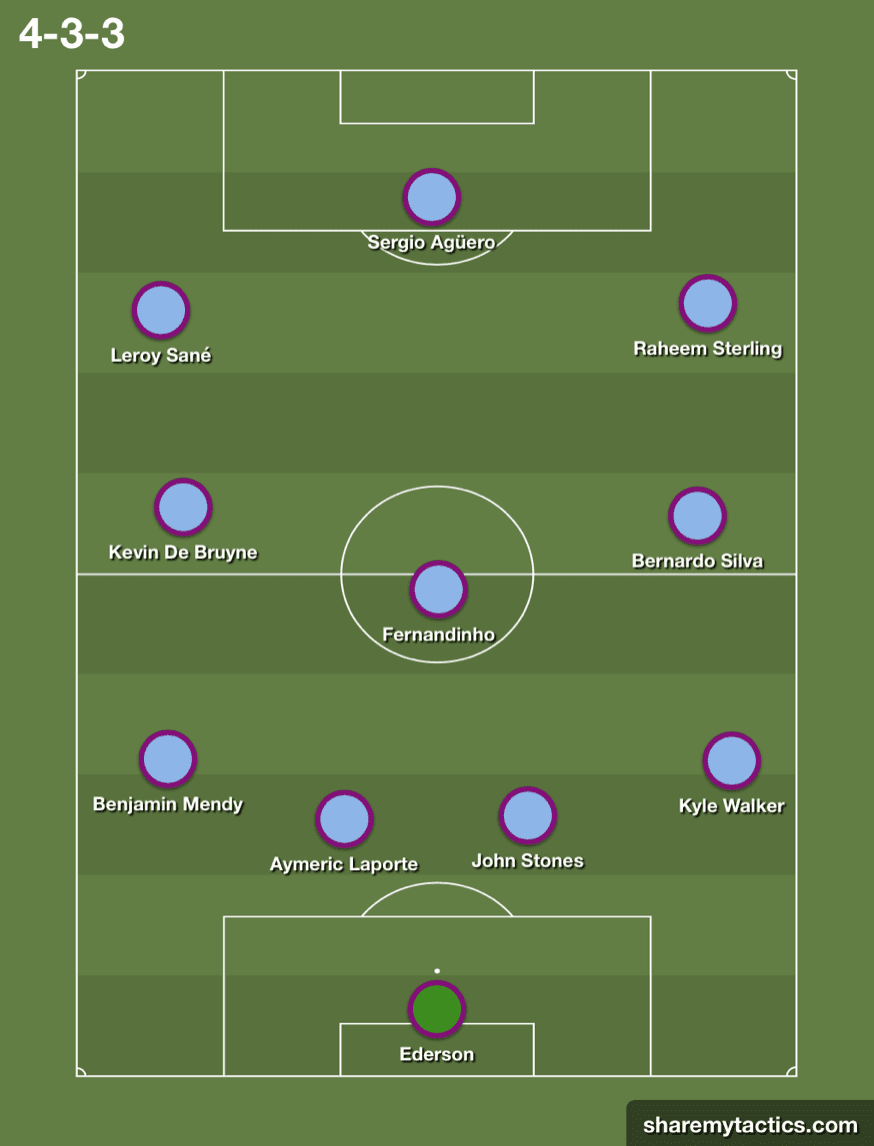
However, regardless of the opponent, or the formation, Manchester City are all about possession-based football.
The thinking behind it is that the opposition cannot score if they do not have the ball.
Last season, Manchester City averaged 64% possession in the league, which was more than any other team. Out of possession, they try to win the ball back as fast as possible in order to continue with the attack.
Some teams seem more dangerous without the ball; they thrive in counter-attack situations.
Manchester City are the opposite; they want to be on the ball as frequently as possible within the 90 minutes.
Manchester City in attack
Build-up play
Manchester City use several different tactics to get into the final third depending on how the opposition are playing.
Against the teams that sit back, Manchester City usually find it quite easy to pass through them.
With the ball deep in their own half, the Manchester City defenders have a lot of space to run into and make a pass forward.
Aymeric Laporte is explicitly Manchester City’s most comfortable defender on the ball.
With a 92.3% pass success percentage, averaging only 0.3 bad controls per game, and only being dispossessed typically 0.1 times per game, Laporte can be depended on to bring the ball up, especially when the opposition leaves space open for him to run into.
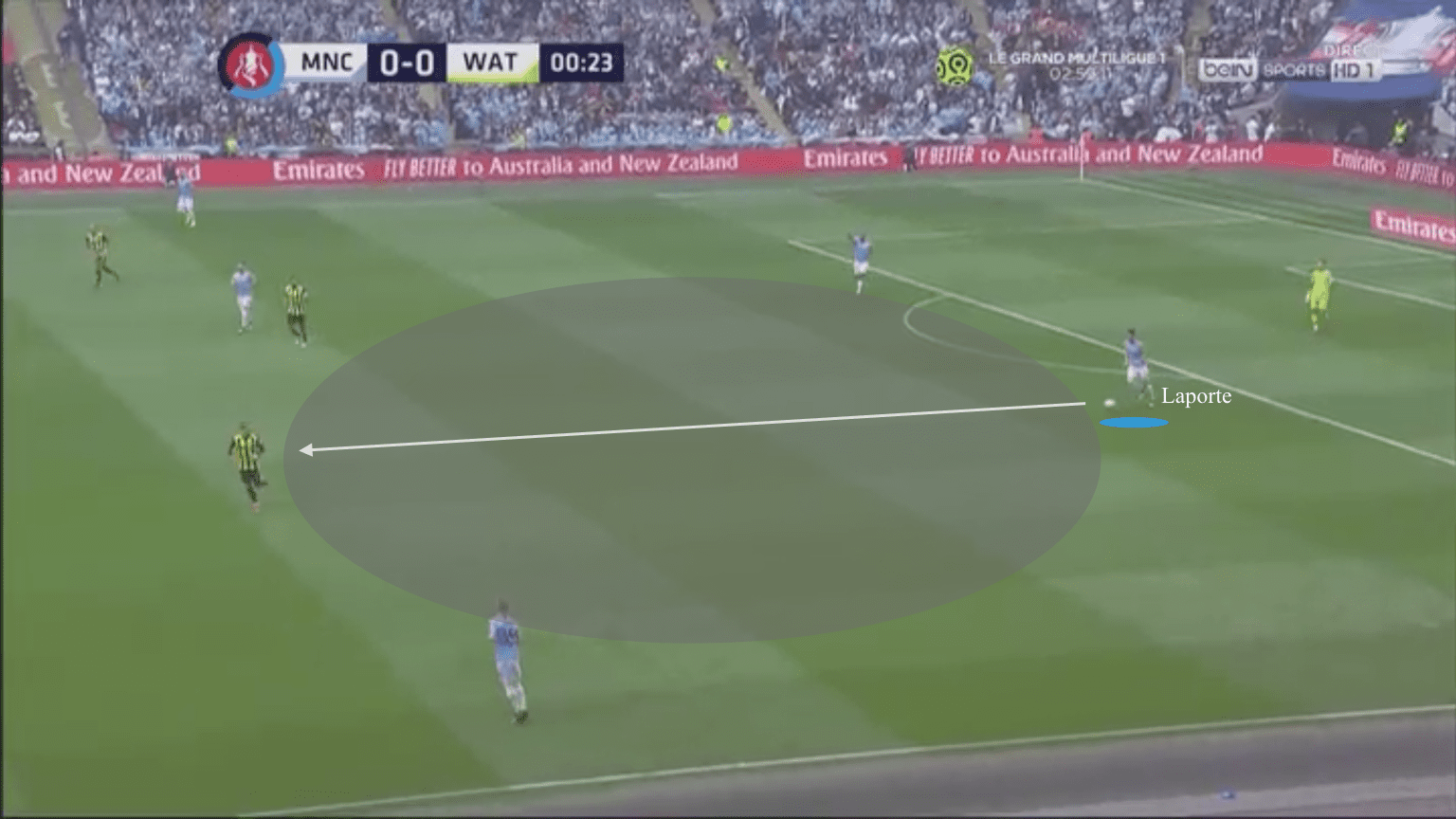
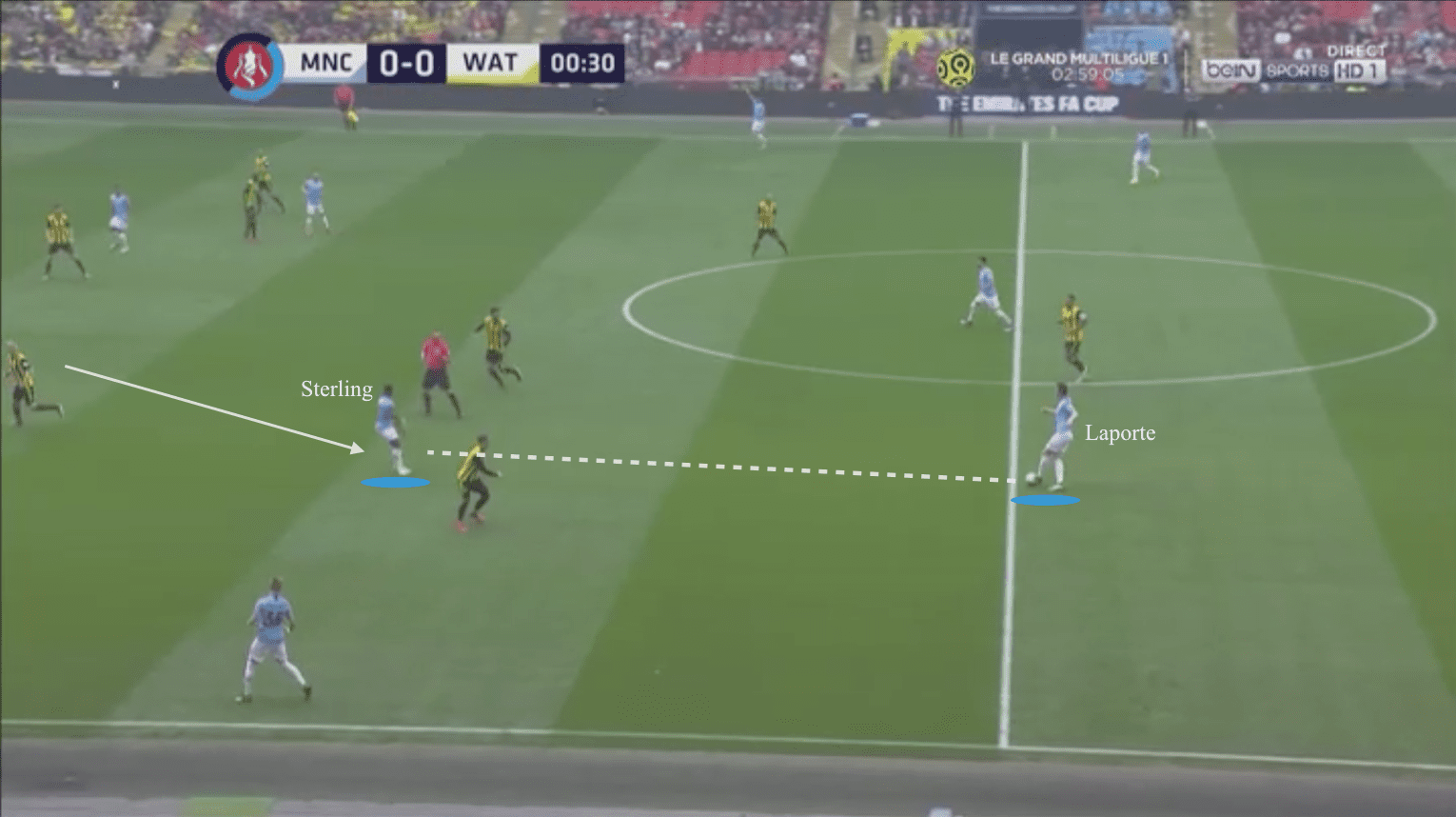
When teams decide to press Manchester City, they do not have the luxury of having a player bring the ball up into open space.
Instead, they navigate through the press with short quick passes.
This is a risky tactic, and many teams would easily give up possession while they are in such small proximity to the opposition players.
However, Manchester City’s extremely technical players are able to pull it off.
The quick passes will achieve one of two things.
The first is the opposition will tire from their press, and it will become a half-hearted effort.
The second is the opposition get disoriented with the press and are unable to make it effective.
Either or work for Manchester City.
Once one of those two things happen, gaps are made, and the Manchester City players have an extra moment on the ball.
This allows them to quickly take the chance with a long pass, usually switching flanks.
Usually, the receiver of the long pass is not marked, because the opposition were pressing where the ball previously was.
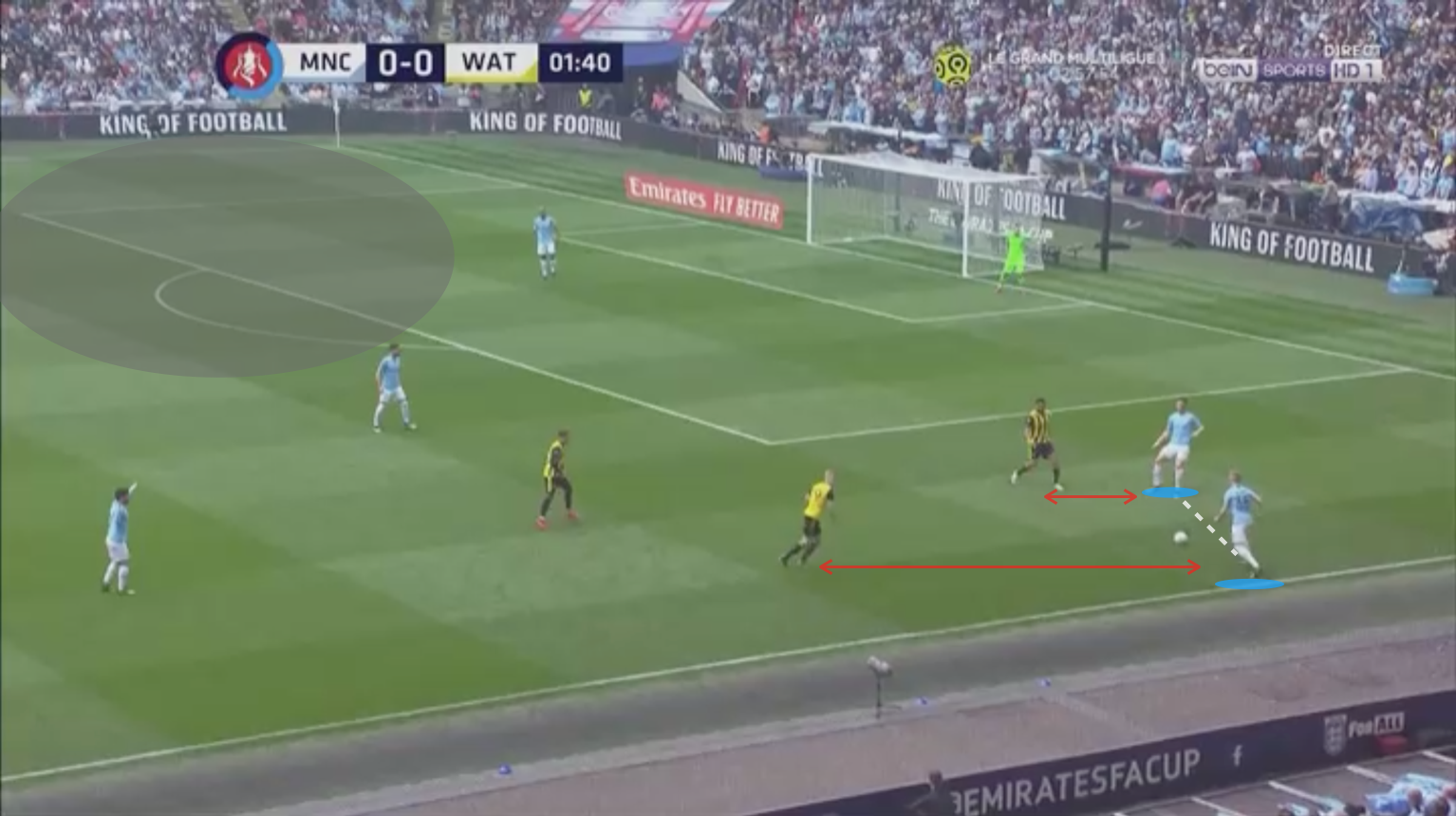
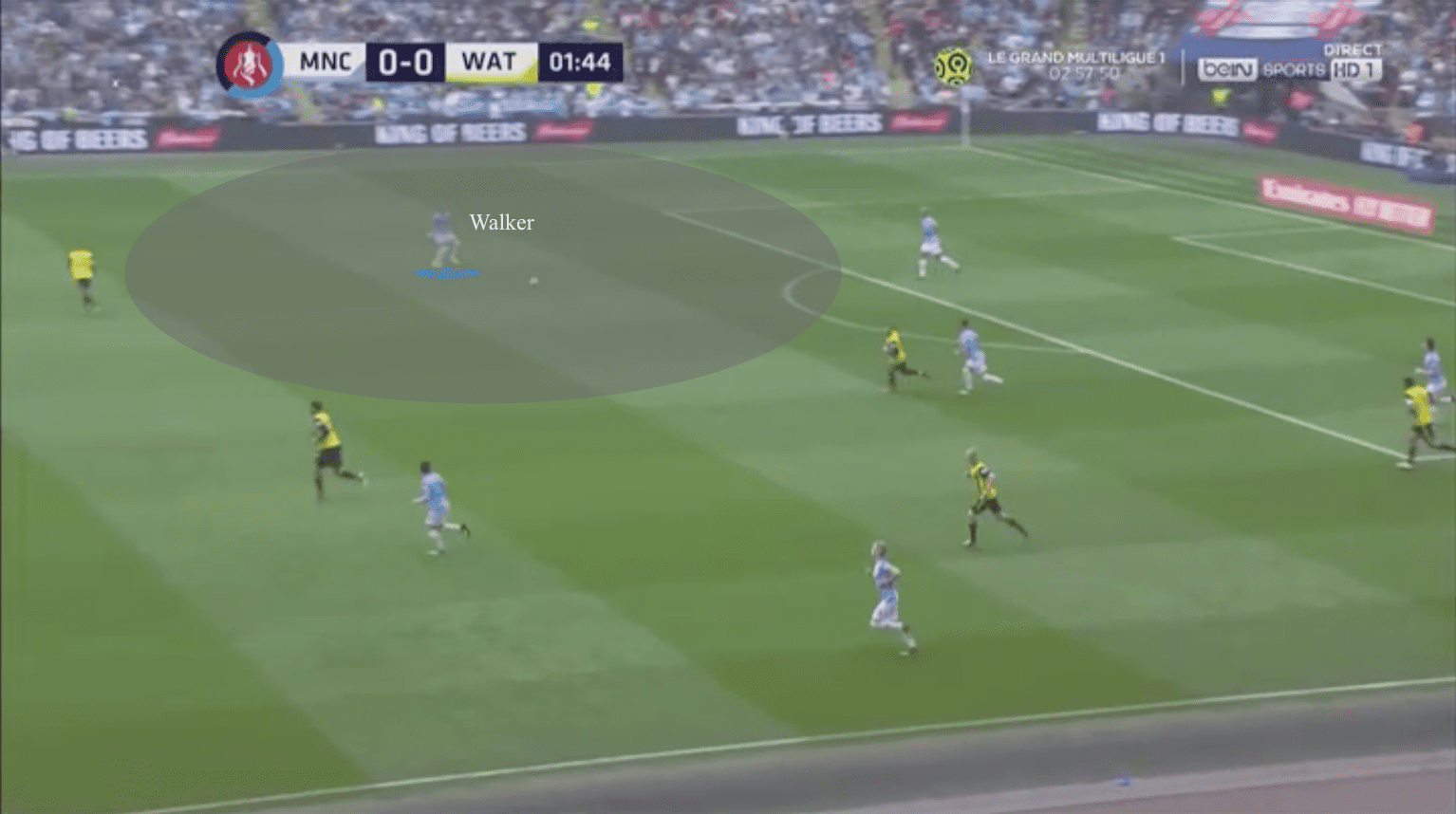
In the final third
Once Manchester City reaches the final third, their formation looks like a 2-3-5.
The three forward player, plus the two fullbacks look to create goal-scoring opportunities in several different ways.
Having five players on the full attack is a nightmare for any team to defend against, especially when the players are as good as the ones Manchester City have.
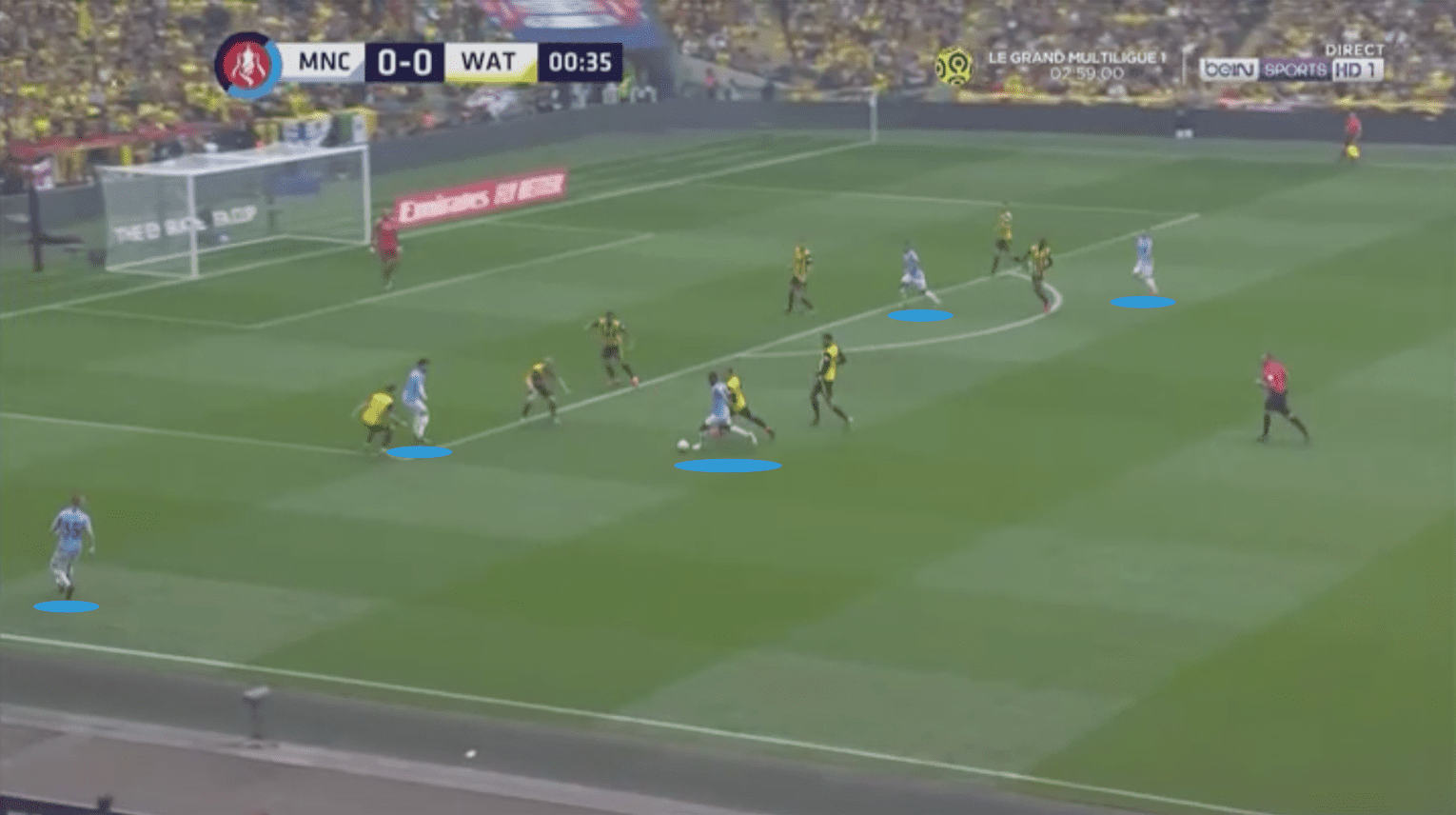
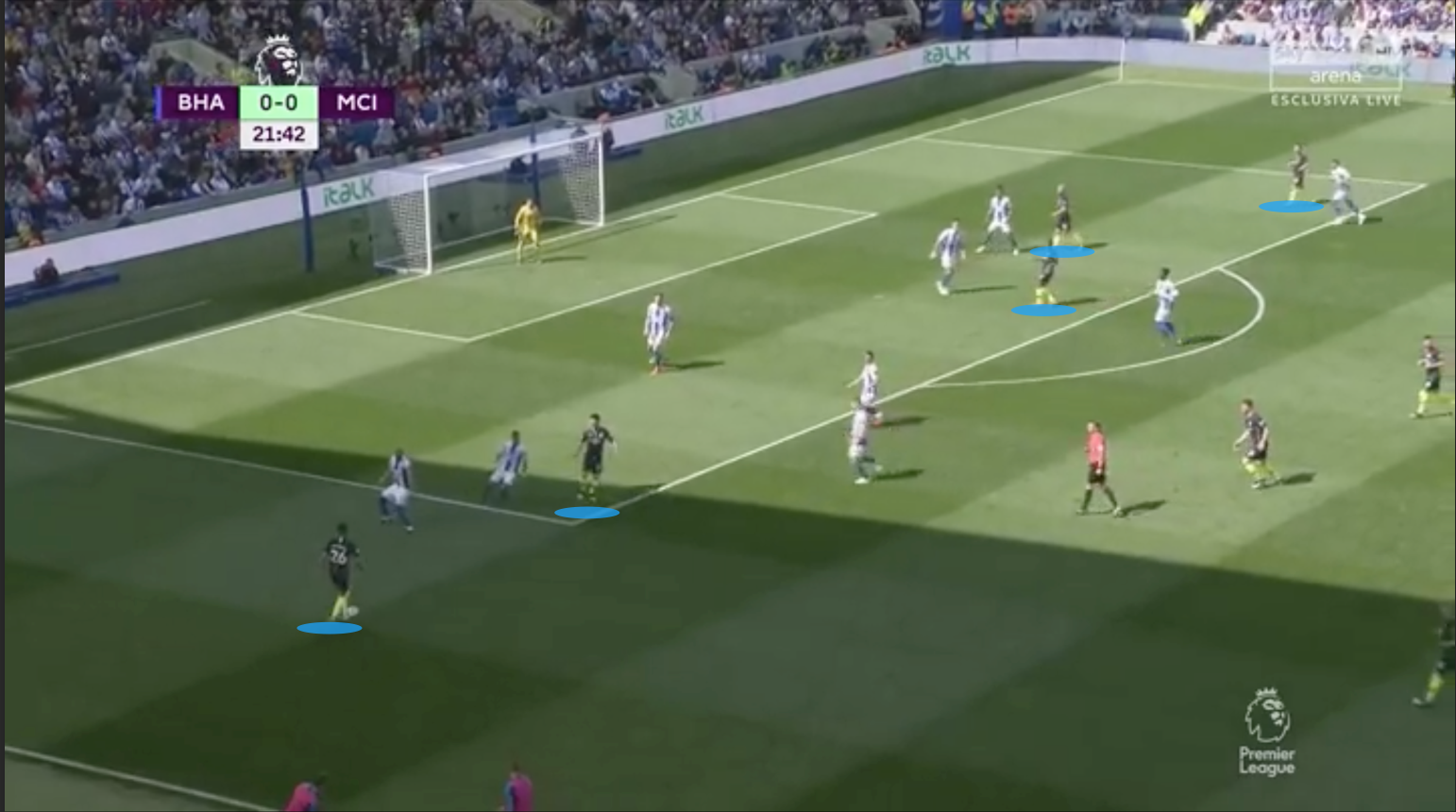
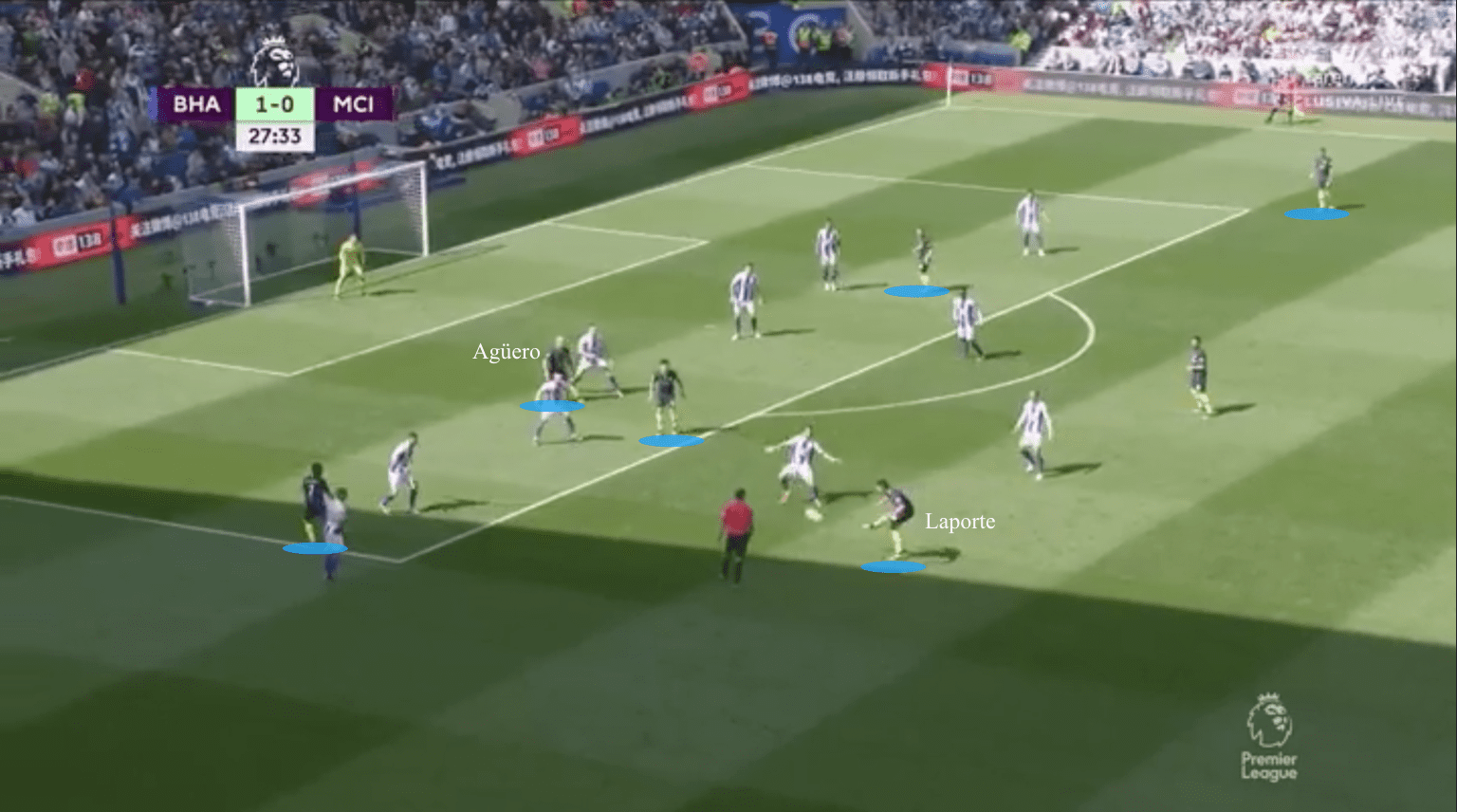
When watching Manchester City in possession, it is clear they have a few distinct ways that they try and create goal-scoring opportunities.
In the 2-3-5, the five forward players stretch the pitch and attempt to use it in its full.
This creates a few dilemmas for the opposition’s defensive line.
More often than not, no matter who they decide to cover, they leave a gap for someone else to exploit.
One of Manchester City’s plays when one of the central midfielders has the ball is for one of the five forward players drops deep to collect the ball.
The opposition’s full-back will often follow, leaving a gap that the widest player can run into.
Usually, another defender will come across and try to cover the wide player, but it’s often too late.
By then, the wide player would have already taken the shot or laid it off for a simple tap-in.
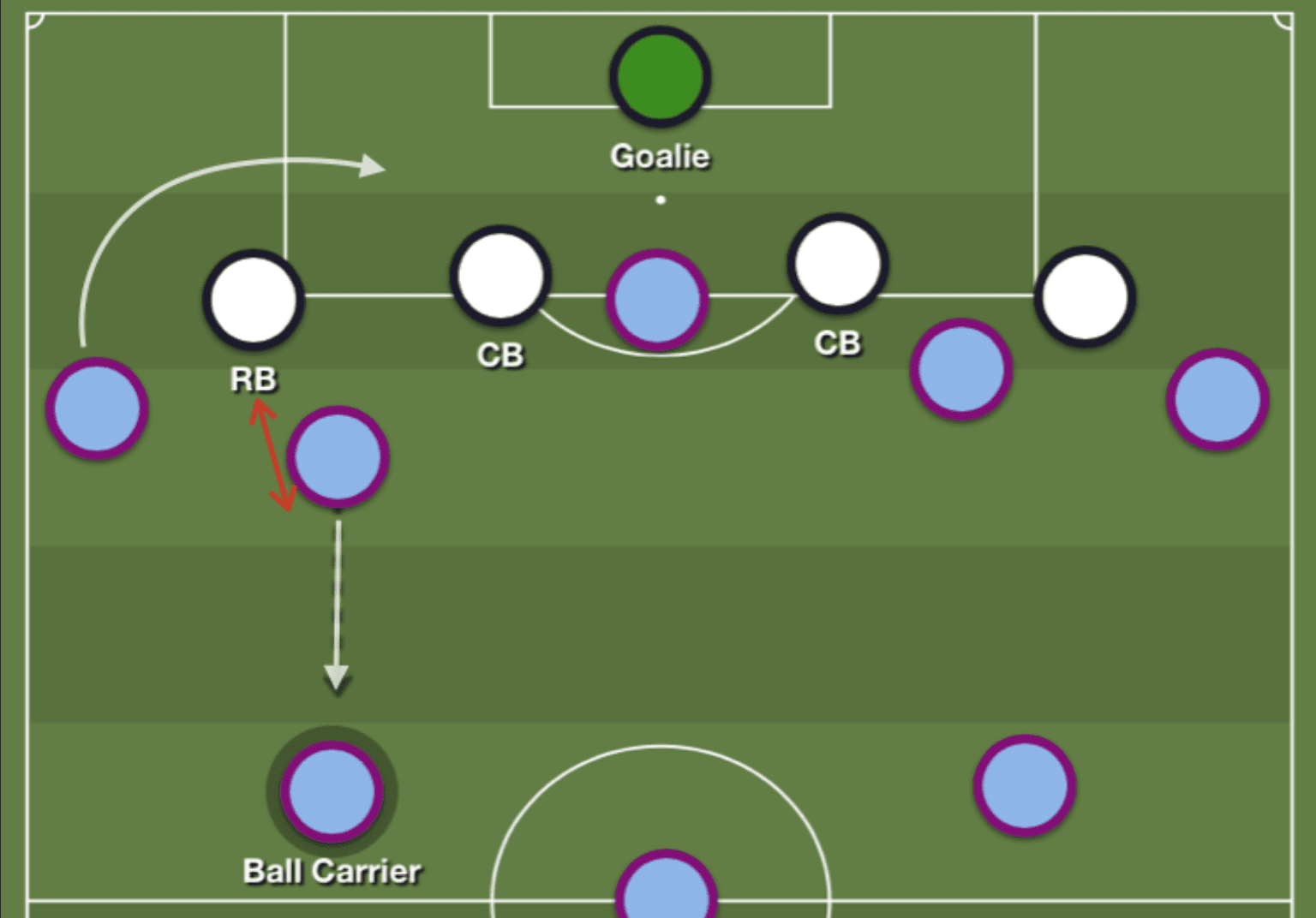
If the ball starts out wide, often the four other forwards will make runs into the box, anticipating a cross.
If the fullback attempts to stop the cross, it leaves a 4v3 in the box, in Manchester City’s favour.
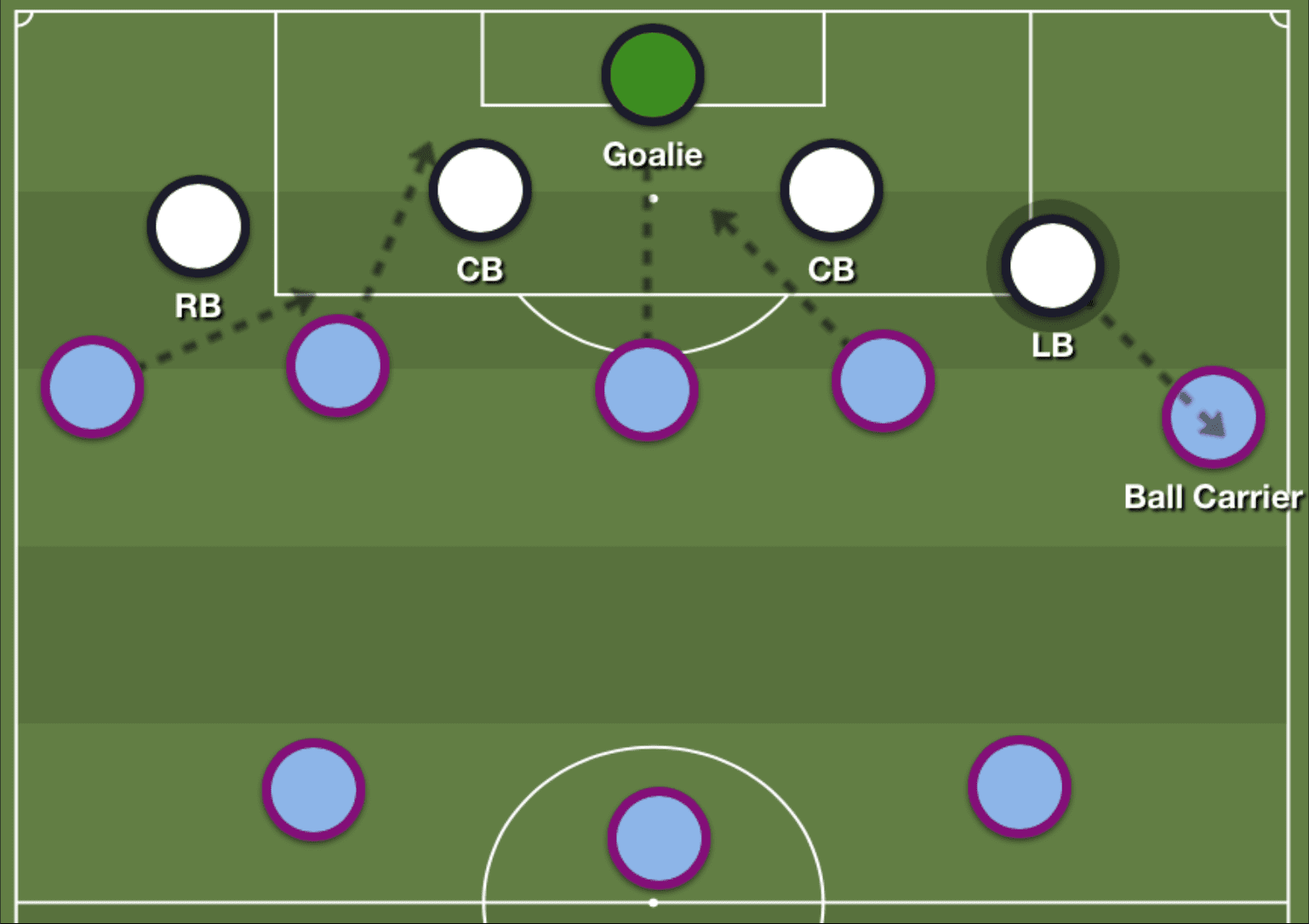
It is difficult for the opposition to cope with Manchester City’s makeshift front five because gaps will be left regardless.
If the wingers are not marked, they will be free to roam inside the 18-yard box.
If the defence focuses on the wingers, the two central midfielders will either shoot from a distance or create chances using their vision and excellent passing range.
It’s clear to see why Manchester City scored the most goals in the Premier League from open play; 72 goals came from Manchester City’s buildup and interplay into the final third.
Manchester City in Defence
Transitions
Opposition teams usually catch Manchester City on the transition.
When committing so many players forward, a quick change of possession can be dangerous.
Usually, when they lose the ball, Manchester City try to quickly win it back, before it can get into dangerous areas.
If they cannot, the opposition can easily exploit the highline.
Manchester City usually will commit tactical fouls to stop these counter-attacks.
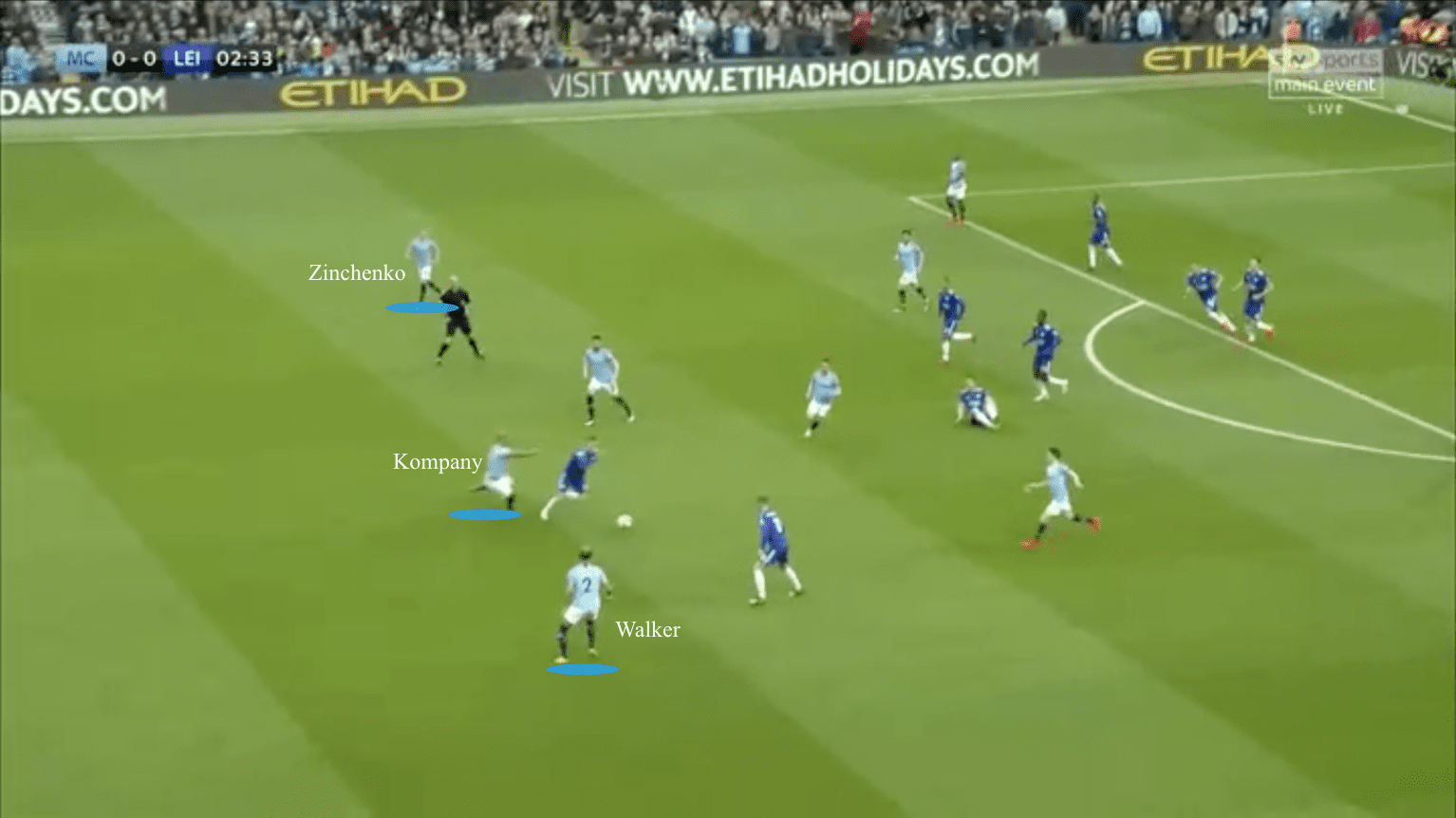
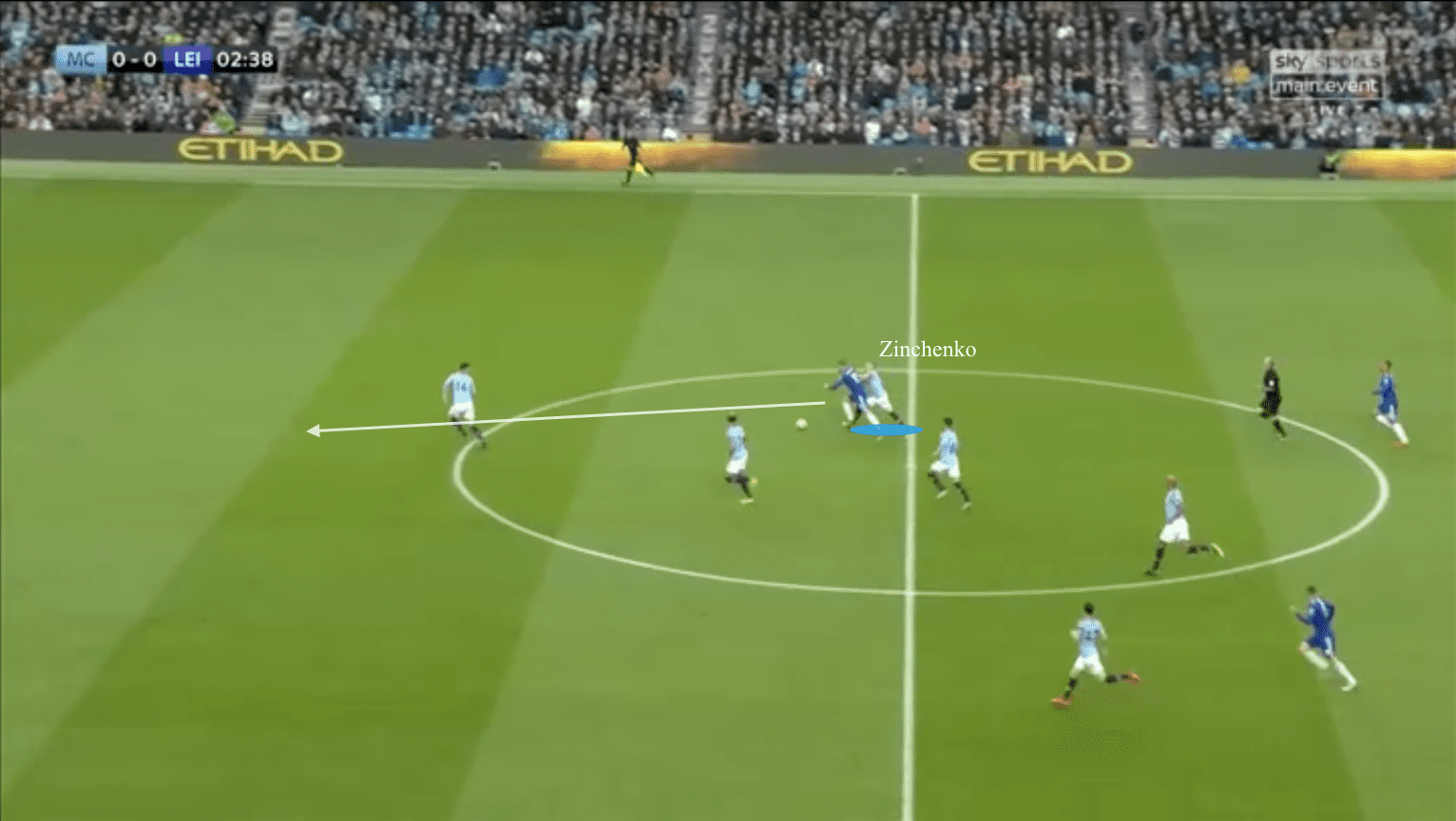
Defensive shape
When Manchester City are unable to win the ball back and feel the opposition is not threatening enough to commit the tactical foul, they will go back into their regular 4-3-3 shape.
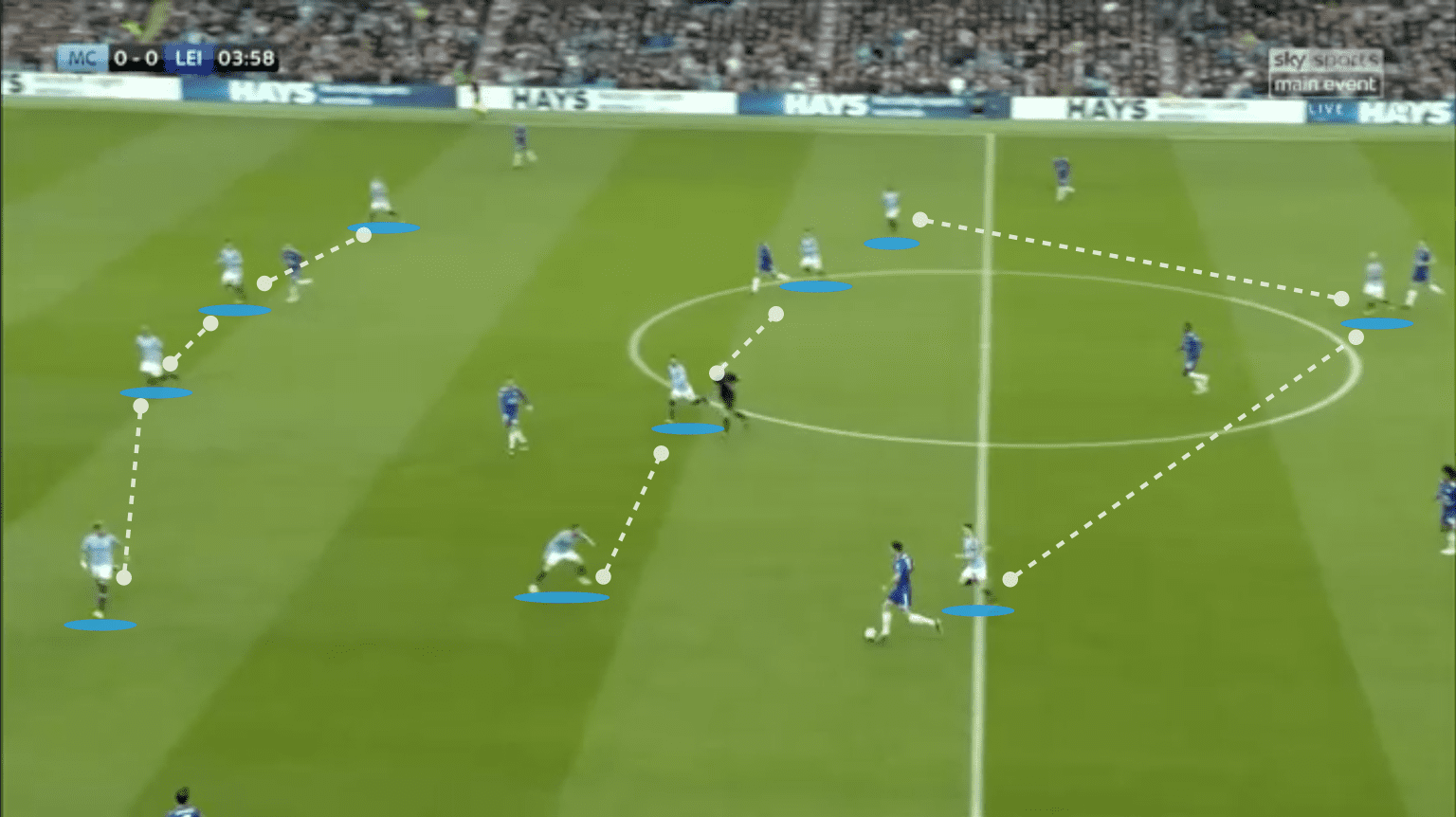
Rodri
Manchester City have not set the world alight during the transfer window.
However, a big-name signing in Rodri will prove to be crucial to Manchester City and make them an even stronger team than they already are
Anyone who watched Manchester City with a critical eye can easily see how important Fernandinho is to the side.
He is essentially a deep-lying playmaker who is involved in almost all of Manchester City’s plays, whether it be attacking or defending.
Unfortunately for him, Fernandinho, who is 34 years old, may not be able to play maximum minutes at the top flight for much longer.
Fernandinho cannot be counted on as Manchester City’s sole defensive midfielder for a full season.
He will get injured, and he will get tired, and while Ilkay Gündogan has his own strengths, he does not offer what Fernandinho has.
After missing out on a few players, Guardiola has found who he wanted in Rodri, and Manchester City officially signed him on July 3rd, 2019.
The Spanish international was obviously brought in as Fernandinho’s long term successor.
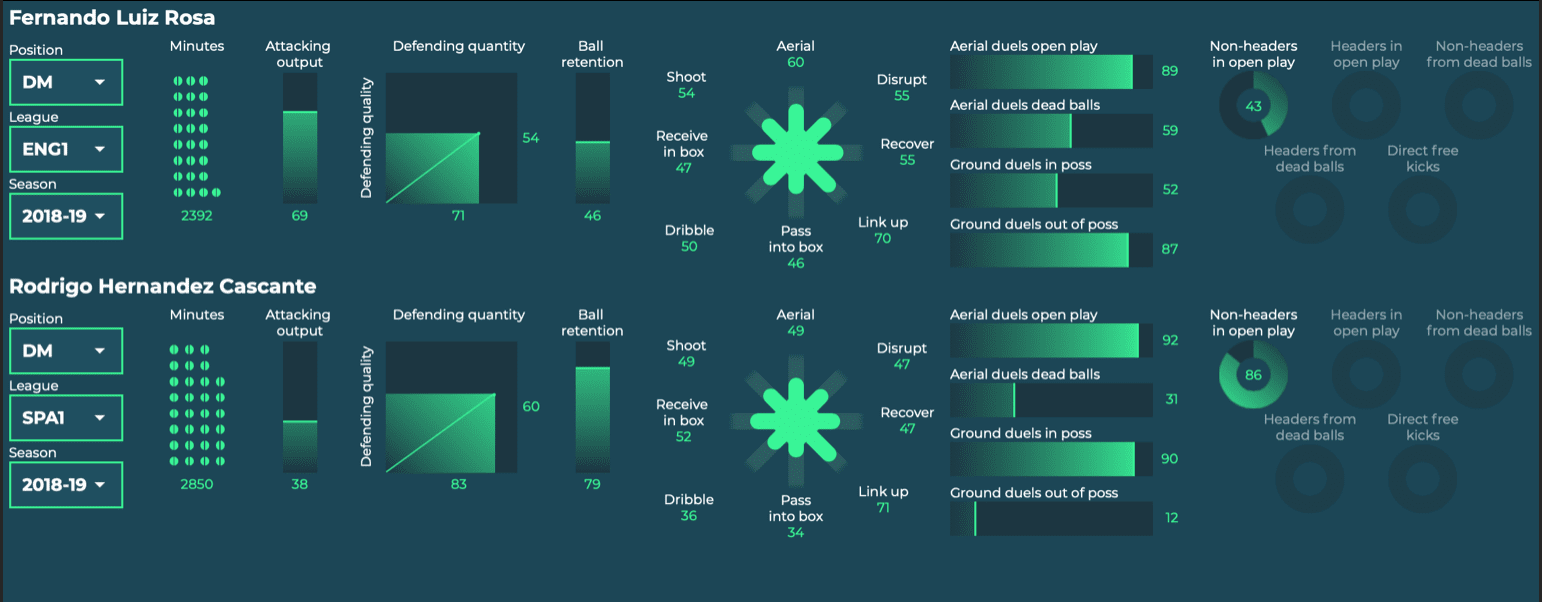
The graph above shows a fantastic representation as to how similar the players are.
When going from left to right, one can see that Rodri’s attacking output is far less than Fernandinho’s.
While Rodri’s playstyle is more defensive, the vast difference in quality can easily be explained by each team’s tactics as a whole.
Atlético Madrid are much more defensively compact than Manchester City.
To further reinforce that Rodri’s play is more defensive than Fernandinho, the graph shows that Rodri spends more time defending than Fernandinho, and does it at a higher level as well.
The most interesting statistics come from the star graph in the middle.
It is uncanny how similar they are.
One of the must-have attributes for a defensive midfielder in Guardiola’s system is the link-up play.
The defensive midfielder is the player that joins the defence and the attack together.
Both Rodri and Fernandinho have great link-up play, and it is shown here that it is one of their best attributes.
Of course, there will be differences between the two players.
Fernandinho has a much better ability at winning ground duels, and Rodri’s ball retention is unmatched.
However, the similarities are apparent; it would come as a big shock if Rodri does not become one of Manchester City’s most essential players in the long run.
Adapting to Guardiola’s system
One aspect that may take time for Rodri to grasp is playing on his own rather than in a double pivot.
Atlético Madrid under Diego Simeone have almost always played in a 4-4-2.
Rodri often had a midfielder beside him to help him sweep side to side; it will take time for him to adapt to playing as a lone defensive midfielder, and carrying the weight on his own shoulders.
Champions League woes
Since Guardiola has come in, Manchester City have crashed out in the Champions League in dramatic fashion.
Usually, the reason for elimination are questionable tactics by Guardiola.
In the quarter-finals in 2018, Guardiola decided to change his system a bit.
Playing Walker and Laporte as inverted fullbacks behind David Silva and Kevin De Bruyne proved to be a mistake.
Having inverted fullbacks leaves your central defenders isolated and sometimes susceptible to counter-attacks, Liverpool’s greatest strength during the 2017/18 season.
Mohammed Salah and Sadio Mané were able to get in behind the defensive line several times across both legs, forcing Vincent Kompany and Nicolás Otamendi to face them 2v2.
Furthermore, Gündogan was deployed on the right-wing, a position he is clearly not comfortable in.
He kept on wanting to come into his natural central position, which made him no threat going forward at all.
The second leg saw Guardiola play a very attacking lineup to try and make up the three-goal deficit.
However, again it left them vulnerable, and once Liverpool were able to get out of a deep block, they finished the tie off.
In 2019, Manchester City were drawn against Tottenham Hotspurs in the quarter-finals.
Again, Guardiola’s tactics were very questionable.
At the New White Hart Lane, Guardiola set up very defensively.
Manchester City were very rigid and offered very little offensively.
They ended up losing the game because they were unable to score.
The second leg saw Cristen Eriksen man-marking Gündogan forcing Manchester City towards long balls.
Tottenham Hotspurs also had their problems; they conceded three goals in twenty minutes.
But unlike Guardiola, Mauricio Pochettino was able to fix the issues he had involving their fullbacks midgame.
Of course, the Champions League is a challenging competition to win, and Manchester City should not expect a smooth ride into the latter stages of the competition.
However, their team on paper is one of the strongest in the competition.
Guardiola seems to overthink his tactics when it comes to the latter stages of the Champions League, and so far, it has cost his team.
Quadruple?
Before being knocked out of the Champions League, all everyone could talk about was if Manchester City would be able to complete the unprecedented quadruple.
Regarded as one of the best Premier League teams of all time, they are seen as the favourites for the three domestic competitions, and one of the favourites for the Champions League.
However, the number of games to compete in four competitions is gruelling, and even with Manchester City’s depth, it’ll be incredibly tough to go out and win over fifty matches.
In the 2018/19 season, Manchester City were quite lucky to not face any very tough opposition in both the League Cup and the FA Cup; they only played one top team in both competitions, which was in the final.
It’s hard to imagine that the luck of the draw will be on their side two years in a row.
When it comes to the league, Manchester City are favourites, and it is expected that Liverpool will be right up there, challenging them.
However, Tottenham have made a few crucial signings that could allow them to challenge for the title throughout the season.
Manchester City are a fantastic team, with a world-class manager.
Through the analysis, we can deduce that Manchester City’s team by looking at their tactics and statistics prove that they can compete with Europe’s best.
However, winning the four trophies is a feat that has never been done before.
Manchester City will not only need to have a near-perfect season; they will also need lot of luck on their side if they are to become the first to ever win a quadruple.
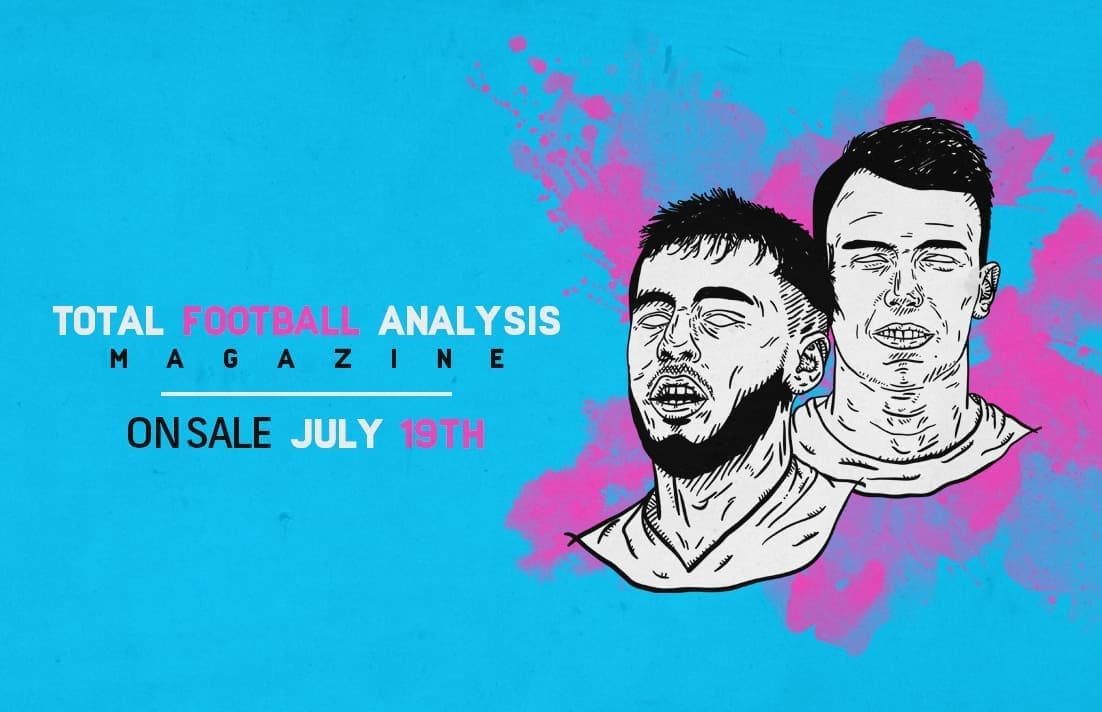
If you love tactical analysis, then you’ll love the digital magazines from totalfootballanalysis.com – a guaranteed 100+ pages of pure tactical analysis covering topics from the Premier League, Serie A, La Liga, Bundesliga and many, many more.
Buy your copy of the July issue for just ₤4.99 here, or even better sign up for a ₤50 annual membership (12 monthly issues plus the annual review) right here.

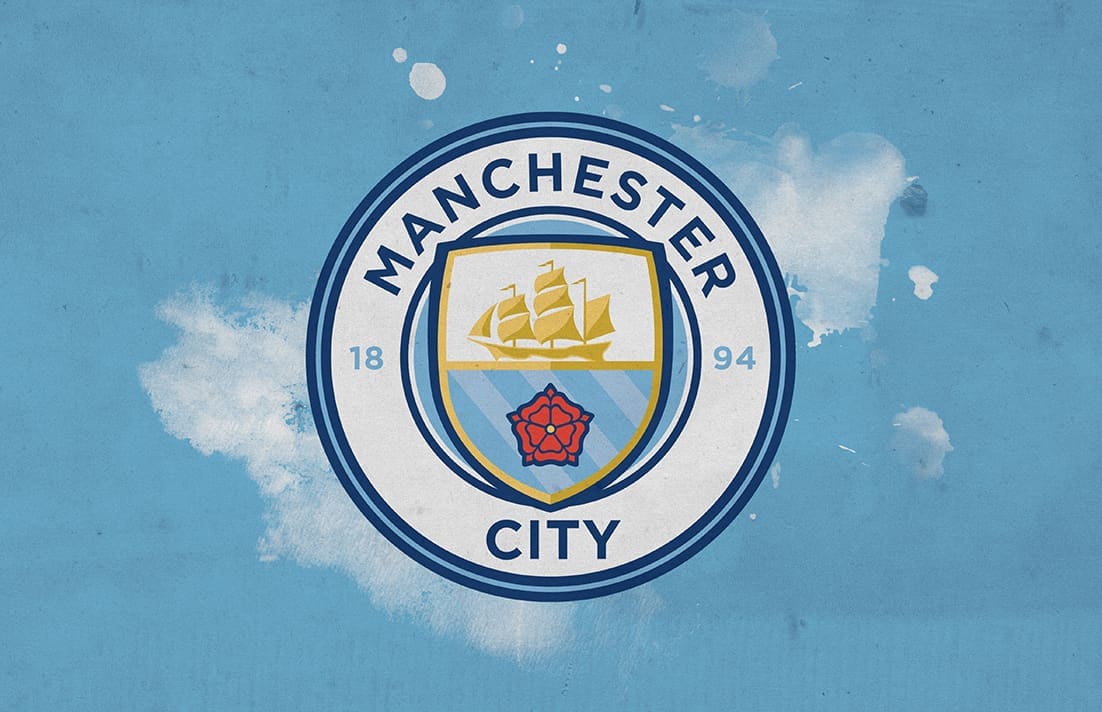




Comments